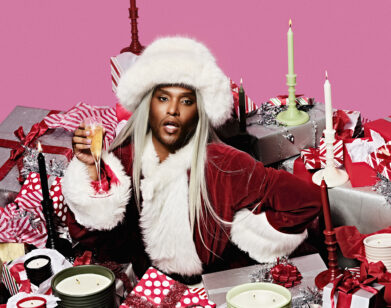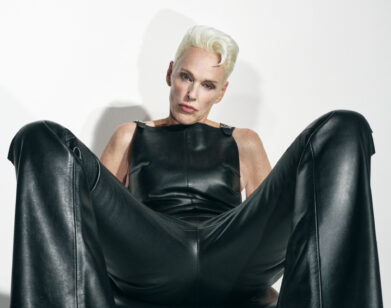in conversation
Lewis Hamilton and Law Roach Meet at the Intersection of Fashion and Activism
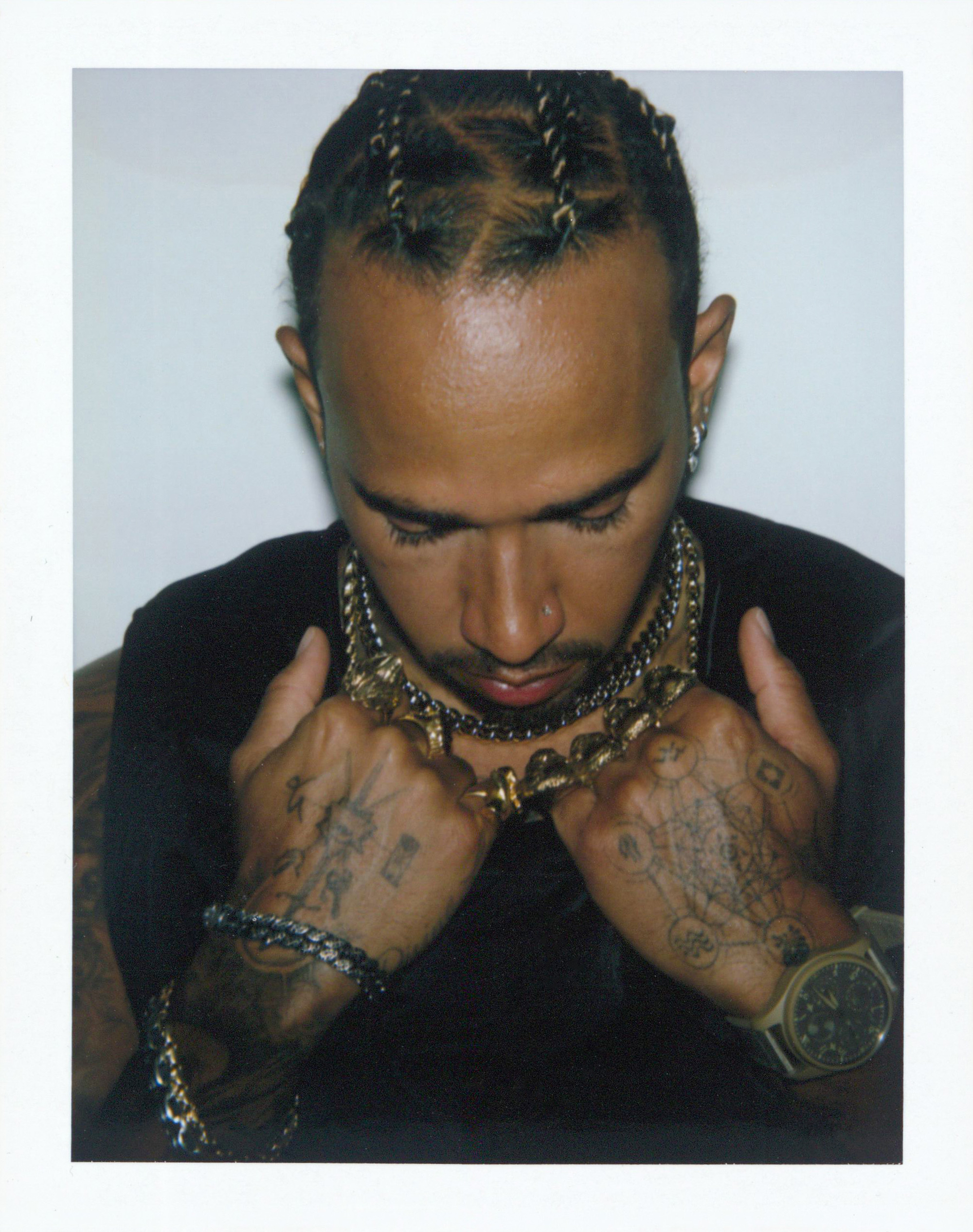
Vest by A Cold Wal. Pants by Kenzo. Sunglasses by Gentle Monster. Necklaces (top to bottom) by Gld and David Yurman. Rings by Johnny Nelson. Bracelets (top and bottom) by David Yurman. Bracelet (middle) by Gld. Watch by IWC Schaffhausen. Boots by Fendi.
Lewis Hamilton is fearless, not just on the racetrack, where he’s won an unprecedented 99 Formula One races, but in his style choices, too. As he’s risen to become a global sports icon, the seven-time F1 champion has made fluency in fashion part of his persona, frequently photographed in a bold and eclectic mix of statement streetwear, neon colors, dapper suits, and playful patterns. Earlier this month, Hamilton was seen sitting front row at the Balenciaga couture show at Paris Fashion Week, in an all-black look courtesy of Law Roach, the celebrity stylist responsible for reinventing Celine Dion into a late-career style icon and helping Zendaya become a red carpet standard-bearer.
As persons of color in industries where there has historically been few, Hamilton and Roach see in themselves kindred spirits, trailblazers who are enacting the change they want to see. For Hamilton, that has meant working to improve representation and create more opportunities for people of color within the world of Formula One and in the British education system more broadly, through a commission he formed with the Royal Academy of Engineering to identify barriers to the recruitment and progression of Black people within UK motorsport, and provide recommendations on how to address them. (These efforts are conducted through Mission 44, a foundation named after Hamilton’s racing number dating to his days of childhood go-karting.) Included in the commission’s recent findings: Among the tens of thousands of jobs in Formula 1, only one percent of employees are Black; of 500,000 teachers in England, only 2 percent are from Black backgrounds, and that in 2019, Black people accounted for just 2 percent of engineering apprentices. Needless to say, there’s still a long way to go, and the first step, as both Hamilton and Roach well know, is starting a conversation.
———
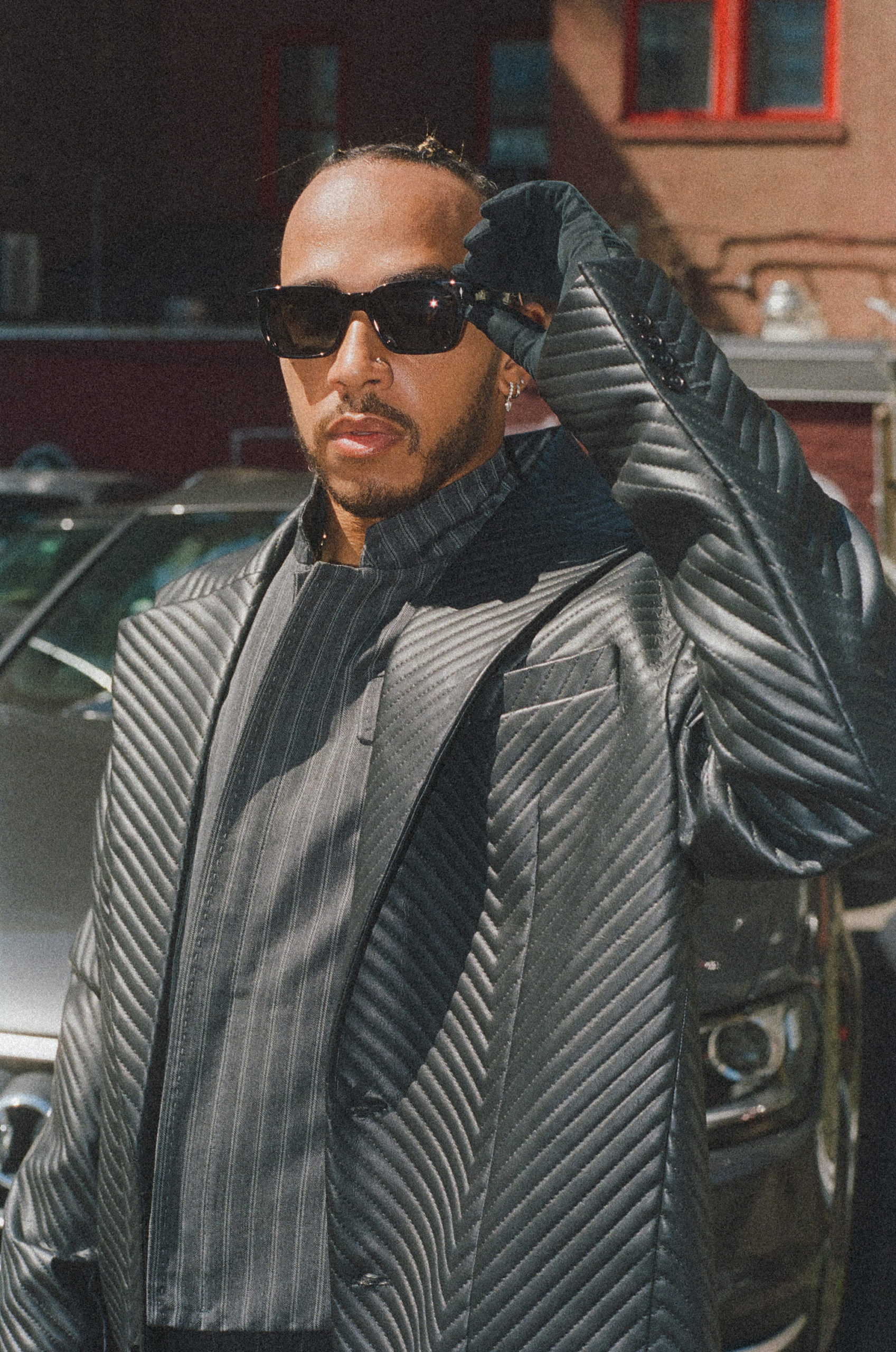
Coat by Tokyo James. Vest, Pants and Gloves by Salvatore Ferragamo. Sunglasses by Gentle Monster. Necklaces (top to bottom) by Gld and David Yurman.
LEWIS HAMILTON: Hey, brother. How are you?
LAW ROACH: I’m good. How are you?
HAMILTON: Yeah, I’m good. Have you been happy with the looks so far?
ROACH: Very. How do you feel about it?
HAMILTON: I’ve been enjoying it. I’ve never seen so many clothes. Each time it’s different and edgy. I’m working with brands that perhaps I haven’t necessarily done a huge amount of work with before. Yesterday was great, at Balenciaga. Also, I love the simplicity of some the looks.
ROACH: I love the all-black look [which Hamilton wore at the Balenciaga couture show in Paris]. I think that was my favorite. It’s just easy.
HAMILTON: Super easy.
ROACH: And I love that picture of you, Kanye, and Demna [Gvasalia, Balenciaga’s creative director]. I thought it was really cool.
HAMILTON: It’s the first time I’ve seen Kanye in a while. I’ve not seen him with his new look. You know when you’re talking to someone, and you can’t see their eyes? It’s already been difficult with COVID. I guess it’s good because you can see people’s eyes, but you can’t see their inflections when they’re speaking to you because they’ve got a mask on. And he’s got a whole mask on.
ROACH: And he didn’t take it off, did he?
HAMILTON: Nope. My friends were messaging me like, “Is it really him? Or is he just sending a body double?”
ROACH: I love that he’s committed. “This is my look.”
HAMILTON: Super committed. I love when people go in their own directions, and they don’t care what other people think. That’s how it should be.
ROACH: It’s powerful.

Coat and Shirt by Burberry. Rings (worn on ring and index fingers) by David Yurman. Ring (worn on middle finger) by John Hardy. Necklaces by Chrome Hearts. Watch by IWC Schaffhausen.
HAMILTON: Can I just say congratulations on your piece with Halsey? It’s so good.
ROACH: Thank you. She did a whole visual album and we shot that in Prague for a month. The entire project comes out next month. So that’s the album cover. And for the intro to the album cover, she literally shut down The Met. For the entire project, we did 24 looks. It’s going to be quite incredible when the whole thing drops.
HAMILTON: Wow. Did you say Prague? That’s a trip.
ROACH: Yeah. In a 16th or 17th-century castle that we shot the whole thing in. We shot it like a movie. It’s going to be really interesting when it comes out. I’m excited for that.
HAMILTON: We don’t know each other that well, but we’re getting to know each other, so I’m interested to know where you started. How have you found the journey of tapping into your creativity, and where are you taking inspiration from? Because you’re very bold and conceptual with your ideas.
ROACH: They say there’s a very thin line between genius and insanity. I happily straddle that line. I get inspiration from anything. A lot of it comes from the past, whether it’s fashion from the past, or my past experiences. But I’m a people watcher, and I have this crazy thing where if I see something that’s interesting, I take a mental photograph of it and never forget it. I’ll reference it when the time is right. So I really just get it from people and from women. I’m super inspired by women. I think being a woman is the ultimate art form. Right? The things that women do to prepare themselves to walk out in the world is art, and that’s my biggest inspiration. It has been since I was a young boy.
HAMILTON: How long have you been in the industry?
ROACH: Professionally, it’s been almost eight years. So, not that long.
HAMILTON: It’s incredible what you’ve done in that short space of time.
ROACH: Thank you so much.
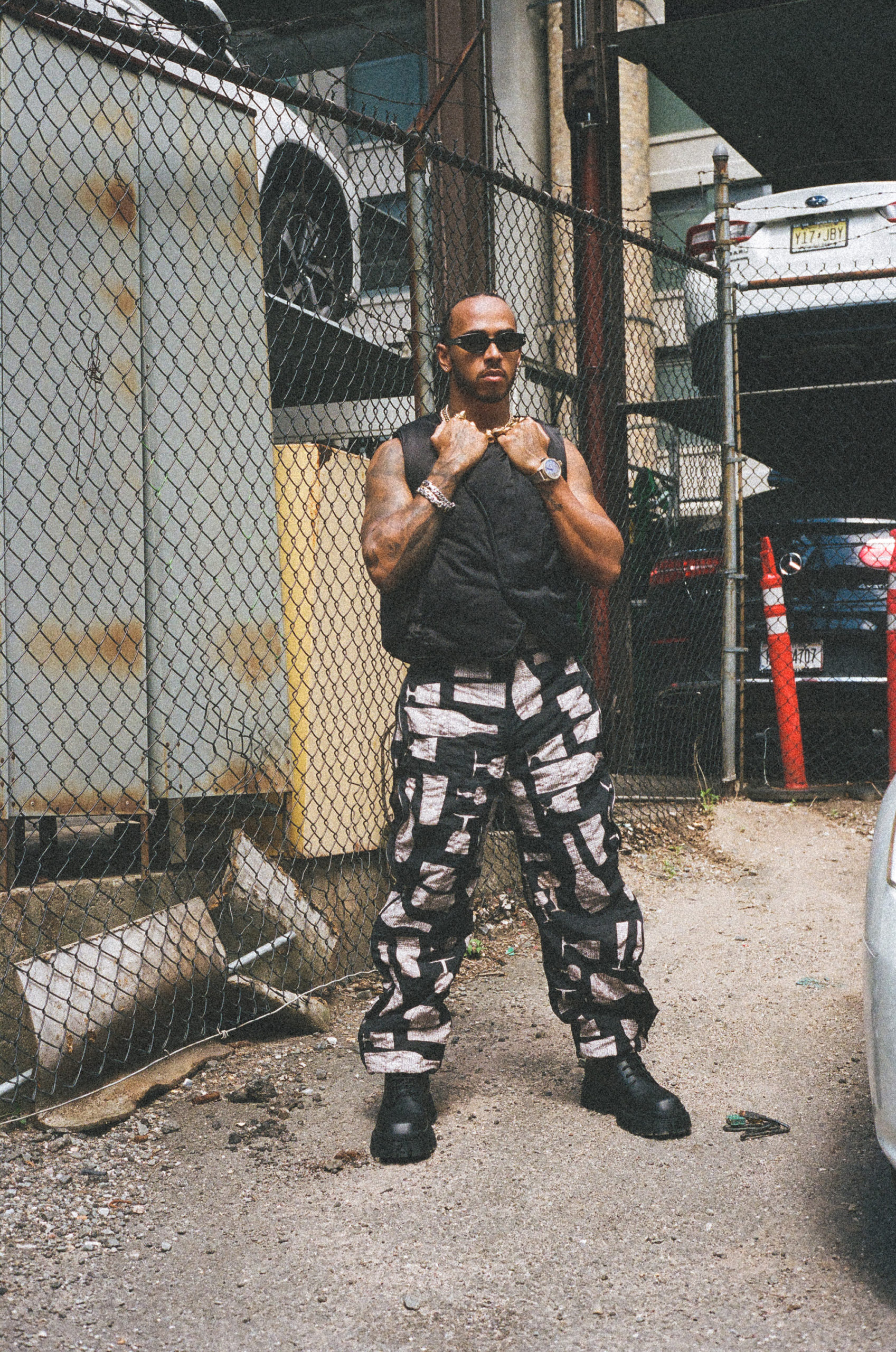
Vest by A Cold Wall. Pants by Kenzo. Sunglasses by Gentle Monster. Necklaces (top to bottom) by Gld and David Yurman. Rings by Johnny Nelson. Bracelets (top and bottom) by David Yurman. Bracelet (middle) by Gld. Watch by IWC Schaffhausen. Boots by Fendi.
HAMILTON: You’re obviously such an impactful force within the fashion community. One thing I really admire is that you’re constantly pushing for more diverse inclusion within the industry. It’s so needed. And uplifting talented individuals by creating moments like we were just talking about with Halsey. How has that journey been, in terms of pushing for that within the industry?
ROACH: I always lead with the question: Is it talent or opportunity? For creative people of color, we hadn’t been afforded the same opportunities as our white counterparts. When I started to book these big jobs and campaigns, I would look around and I was the only Black person there. That made me feel bad, because I never wanted to be the only one in the room. So, when I got a little ounce of power or input or influence, I thought that I should say something, and I should fight, and I should advocate to see other people get the opportunity. So it’s just that question of talent and opportunity. Black people are some of the most brilliant, creative, and beautiful beings on the planet. We just are not always afforded the same opportunity. Everything I do, everything I say, I do because it’s the right thing to do.
HAMILTON: I can really relate to that, because since I’ve been in this industry, when I arrived at shoots or even just being at the racetrack, I felt like, “How am I the only one here?” I was always lucky when I was young because I had my dad with me. I had this powerful Black man to go along with me. So I didn’t necessarily feel too alone. But obviously, in the professional world, I ended up standing on my own two feet, and then I felt like I had to use the platform to somehow create the change that I wanted to see.
ROACH: How do you feel that experience has impacted the work you do on and off the track, in a broader way?
HAMILTON: It’s been an interesting journey. I’ve definitely felt that “just be quiet and do your job” thing in the early stages of my career. I felt like I had to conform, like I had to be a certain shape. It’s like you have to be a square or a circle to get into this industry, and no other shapes fit. I knew I was a different shape, and I felt like I had to squeeze myself, just to get through the door. And once I got in, then I could start discovering myself and letting my branches grow. I think I’ve been more outspoken because I’m very daring—I don’t really have that much of a filter. Now, it’s really about action. It’s one thing to say you’re going to do something, and another to actually follow through.
ROACH: It’s important for your words to be the call to action. It has to be followed up with something. When you’re using your platform, and you’re stepping out, and you’re the first, and you’re vocal about change, that one person that stops you on the street or in the airport or wherever is validation that what you’re doing is right. I had a young kid in New York say to me, “I know I can, because you did.” I’ve never forgotten those words. They almost brought me to tears. I feel like my career is not mine anymore. It’s for anybody who finds anything aspirational or inspirational about it. I’ve done everything that I’ve dreamt. I need bigger dreams.
HAMILTON: That’s what I love about you and that’s why I wanted to work with you. Getting awards and things, that’s one thing, but getting that human interaction with people and having that connection is uplifting and powerful, and you just don’t expect it. We’re only human. So there’s days where you’re like, “Am I doing the right thing? Am I doing enough? Is it going to make a difference for someone else?” When you do sometimes hear that, it changes your world.
ROACH: I know you have a lot of things you’re doing outside of racing. Let’s talk about fashion.
HAMILTON: When I first got signed, I wasn’t particularly fashionable. I remember going to this meeting, and my boss looked at me up and down. He’s like, “What are you wearing?” And I never felt like I ever fit in at school. I was always just a bit edgy. I was very much into street fashion and heavily impacted by hip-hop and pop culture. And then, I started going to fashion shows. It opened up my mind because I felt like I belonged in that environment. I felt like I wasn’t being judged for what I was wearing. You see people from all different walks of life, compared to my industry where you walk in and you’re the only one there. When I came to fashion shows, there was a much more diverse group of people. I fell in love with it. I’ve been going through this journey of learning. When you go to all these shows, you’re seeing all these incredible creations, incredible concepts, future thinking, and trendsetting. And I wouldn’t say it’s easy. The pace of this industry is incredible. It’s faster-paced than the race industry.

Jacket, Sweater and Pants by Balmain. Earrings and Nose Ring (worn throughout) Lewis’s Own. Rings on right hand (left to right) Chrome Hearts and John Hardy.
ROACH: You have to do it for you, because if you don’t, you can lose yourself with keeping up with trends, or keeping up with people, or what other people suggest is cool. You have to know who you are, because it’s a carnivorous industry.
HAMILTON: It is.
ROACH: It’ll eat you up.
HAMILTON: And spit you out. But I love that fashion is far more than just putting on clothes. I love how it tells stories, and you’re able to convey confidence, and your swag, and your mood, and your mindset. This last year, I’ve been able to utilize it and really show my stance on issues at the races.
ROACH: I would love to hear more about what Mission 44 is.
HAMILTON: Mission 44 is my foundation that’s just been launched. The idea came up at the end of 2019, and then the whole thing happened with George Floyd. It just happened to coincide with the fact that we were doing this commission, and the commission is to find what barriers are for young Black men and women to get into my industry. There’s something like 40,000 jobs in my industry, and one percent of people are from Black backgrounds.
ROACH: Wow.
HAMILTON: So this is my job. This is why I’m here. I’ve been wondering, “Why are we the only ones?” There’s got to be a reason beyond having success and getting awards. So this commission has now got these ten recommendations, and through research, we found a lot of systemic issues. For example, in education, one-third of young Black students will be expelled in the U.K. between year 9 and 11. I was one of them. That puts you on a difficult trajectory. On the commission, we’ve got people in government, we’ve got people on the ground in Black communities, in education. We’re going to be shifting curriculum, creating scholarships, and working with third parties. The ultimate goal is to make sure that in five or 10 years time, my industry is more diverse. And I hope, when I look back, instead of people being all, “He was a good driver,” I would much, much prefer it to be, “He helped change the way they looked at things. And now it’s more diverse.”
ROACH: I think a bigger thing is to say: “He helped change the world.” Hopefully, the changes that you’re making will influence people in other industries to make the same type of changes. That way, we can literally say, “Lewis Hamilton helped change the world.” And I’m saying that. You could be humble. You don’t have to say it. You can be humble. I will say it for you.
HAMILTON: I appreciate that. We’re both lucky enough to have these platforms that allow us to showcase our views and support our community. I’m actually mixing fashion and activism. I think it can be daunting for some people, but it can help tell better stories. Do you feel pressure in trying to mix those two?
ROACH: I don’t. I’ve looked at it as putting the medicine in the ice cream. You take the scariness away from it when you use something like fashion, which everybody has some type of ownership of. It’s a way to make it digestible without diluting the message. Even when you wear the t-shirt that has a statement on it, so many millions of people are going to see that, and hopefully, it touches someone’s heart or starts a conversation. It took you five minutes to put that t-shirt on. That one decision could easily have impacted millions of people. I think that’s beautiful.
HAMILTON: It’s sparking conversation.
ROACH: Yeah.
HAMILTON: That’s something I learned last year. There’ll be kids watching at the dinner table, and they’ll be saying, “What does Black Lives Matter mean?” It starts a conversation within families that perhaps have never had those conversations before.
———
Grooming: Laila Hayani at Forward Artists
Production: Taylor Brown
Photo Assistant: Tristan Martinez
Fashion Assistants: John Martin, Patrick Lynere, and Posh McKoy


